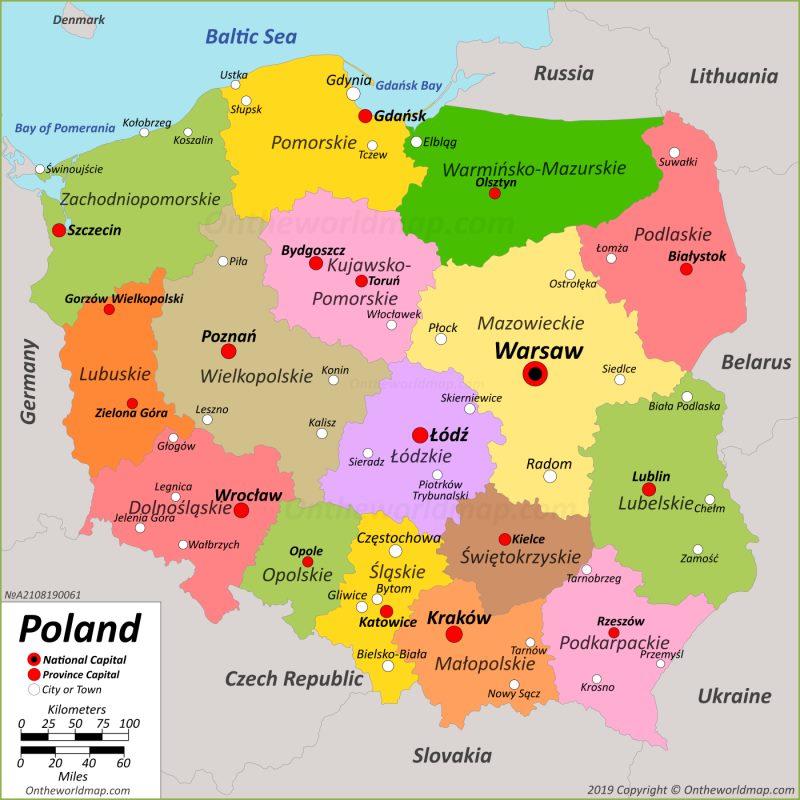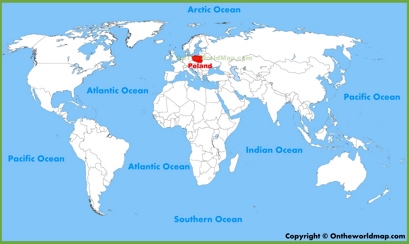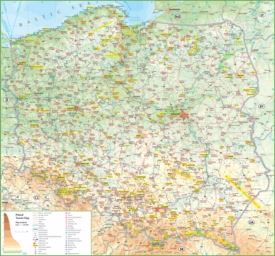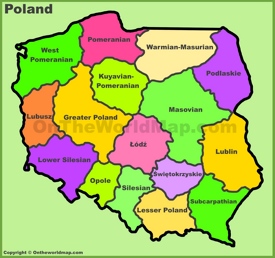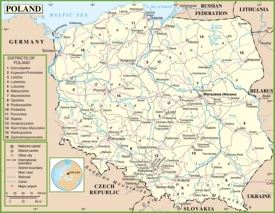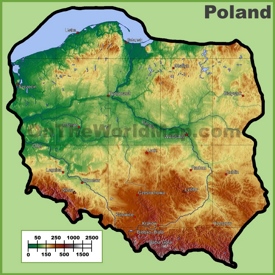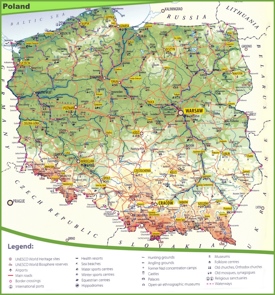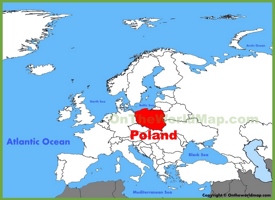Poland Map
Description:
This map shows governmental boundaries of countries; provinces, province capital cities, and major cities and towns in Poland.
Size: 1400x1400px / 689 Kb
Author: Ontheworldmap.com
You may download, print or use the above map for educational, personal and non-commercial purposes. Attribution is required. For any website, blog, scientific research or e-book, you must place a hyperlink (to this page) with an attribution next to the image used.
Online Map of Poland
About Poland
Poland (Republic of Poland) stands as a country in Central Europe with a population of 38 million people, making it the fifth most populous member state of the European Union. The country covers an area of 120,733 square miles (312,696 square kilometers) and shares borders with Germany to the west, the Czech Republic and Slovakia to the south, Ukraine and Belarus to the east, and Lithuania and the Russian exclave of Kaliningrad to the north.
Warsaw serves as the capital and largest city, with 1.8 million residents in its metropolitan area. Other major urban centers include Kraków, Łódź, Wrocław, and Poznań. The country's geography features diverse terrain, from the Baltic Sea coastline in the north to the Tatra Mountains along its southern border. The central regions consist primarily of lowlands, while the country contains over 10,000 lakes, predominantly in the northern region.
Poland maintains a high-income economy, ranking as the sixth largest in the European Union by nominal GDP. The country's economic strength stems from its industrial sector, including machinery manufacturing, metallurgy, and chemical production. Poland also possesses significant coal reserves and maintains a strong agricultural sector, leading European production of potatoes, rye, and beetroot.
The nation's transportation infrastructure includes 233,000 miles (375,000 kilometers) of roads, an extensive railway network, and major international airports in Warsaw, Kraków, and Gdańsk. Poland joined NATO in 1999 and the European Union in 2004, marking significant milestones in its post-communist development.
Tourism plays a crucial role in Poland's economy, with the country receiving over 21 million international visitors annually. Major attractions include the historic center of Kraków, featuring Europe's largest medieval town square, and the Wieliczka Salt Mine, which contains unique salt sculptures and underground chambers. The Auschwitz-Birkenau Memorial and Museum draws visitors as a crucial historical site and memorial to Holocaust victims. The Białowieża Forest, Europe's last primeval forest, provides habitat for European bison and other rare species.
Poland's education system ranks among Europe's oldest, with Jagiellonian University in Kraków dating to 1364. The country maintains 500 higher education institutions serving 1.3 million students. Polish scientists and researchers have made significant contributions across various fields, including Marie Curie's pioneering work in radioactivity.
The Polish healthcare system provides universal coverage through a national health fund. The country operates 948 hospitals and maintains a ratio of 2.4 doctors per 1,000 residents. Life expectancy averages 74.7 years for men and 82.6 years for women.
The country's natural resources include extensive deposits of copper, silver, natural gas, coal, and rock salt. Poland ranks among the world's top producers of copper and silver, with mining operations centered in the Lower Silesian region. The Baltic coastline stretches 273 miles (440 kilometers), featuring popular resort towns and amber deposits, known locally as "Baltic gold."
The Facts:| Flag: |

|
| Capital: | Warsaw |
| Area: | 120,733 sq mi (312,696 sq km) |
| Population: | ~ 38,036,118 (2022 census)[1] |
| Official language: | Polish |
| Religion: |
|
| Currency: | Złoty (PLN) |
| Driving side: | Right |
| Calling code: | +48 |
| Internet TLD: | .pl |
| Time zone: | UTC+1 (CET) Summer (DST) UTC+2 (CEST) |
| Gross domestic product (PPP) 2025 estimate: |
|
| Gross domestic product (nominal) 2025 estimate: |
|
| Official government website: | www.gov.pl |
Google Map of Poland
List of Largest Cities in Poland
Ski Resorts in Poland: Zakopane, Karpacz, Krynica-Zdrój, Ustroń, Małe Ciche, Szczyrk, Szklarska Poręba, Krynica-Zdrój.
The Best Coastal Towns in Poland
- Sopot
- Jarosławiec
- Ustka
- Darłowo
- Łeba
- Dębki
- Jastarnia
- Świnoujście
- Kolobrzeg
- Mielno
Main sights in Poland
- Historic Center of Krakow
- Auschwitz-Birkenau Memorial
- Warsaw Old Market
- Wawel Royal Castle
- Malbork Castle
- Tatra National Park
- Lazienki Park
- Wieliczka Salt Mine
- St. Mary's Basilica, Krakow
- Oskar Schindler's Enamel Factory
- Wawel Cathedral
- Wolf's Lair, Gierloz
- Białowieza National Park
- Slowinski Sand Dunes
- Toruń
- Zamość
- Wieliczka Salt Mine
- Wrocław
Voivodeships of Poland
| Voivodeship | Capital | Area | Population |
|---|---|---|---|
| Lower Silesian | Wrocław | 7,702 sq mi (19,947 sq km) | 2,903,000 |
| Kuyavian-Pomeranian | Bydgoszcz, Toruń | 6,939 sq mi (17,971 sq km) | 2,056,000 |
| Lublin | Lublin | 9,700 sq mi (25,123 sq km) | 2,104,000 |
| Lubusz | Gorzów Wielkopolski, Zielona Góra | 5,401 sq mi (13,988 sq km) | 995,000 |
| Łódź | Łódź | 7,034 sq mi (18,219 sq km) | 2,443,000 |
| Lesser Poland | Kraków | 5,862 sq mi (15,183 sq km) | 3,399,000 |
| Masovian | Warsaw | 13,729 sq mi (35,559 sq km) | 5,432,000 |
| Opole | Opole | 3,634 sq mi (9,412 sq km) | 966,000 |
| Subcarpathian | Rzeszów | 6,890 sq mi (17,846 sq km) | 2,098,000 |
| Podlaskie | Białystok | 7,794 sq mi (20,187 sq km) | 1,182,000 |
| Pomeranian | Gdańsk | 7,075 sq mi (18,323 sq km) | 2,355,000 |
| Silesian | Katowice | 4,762 sq mi (12,333 sq km) | 4,501,000 |
| Holy Cross | Kielce | 4,520 sq mi (11,710 sq km) | 1,216,000 |
| Warmian-Masurian | Olsztyn | 9,333 sq mi (24,173 sq km) | 1,423,000 |
| Greater Poland | Poznań | 11,516 sq mi (29,826 sq km) | 3,486,000 |
| West Pomeranian | Szczecin | 8,844 sq mi (22,905 sq km) | 1,694,000 |
Geography of Poland
The topography of Poland consists of five distinct geographical regions. The northern region encompasses the Baltic coastal plain and the lake-rich Masurian Lake District. The central region features lowlands that stretch across the country from east to west. The southern region includes two major highland areas: the Sudetes and Carpathian Mountains, with the Tatra Mountains reaching Poland's highest point at Mount Rysy (2,499 meters).
Poland's climate exhibits transitional characteristics between oceanic and continental systems. Summer temperatures average 16-19°C (61-66°F), while winter temperatures range from -6 to 0°C (21-32°F). Annual precipitation varies between 500-700mm, with higher amounts in the mountains. The growing season spans 180-190 days across most of the country.
The country's major rivers include the Vistula (Wisła) and Oder (Odra), which flow northward into the Baltic Sea. These rivers, along with their tributaries, form crucial transportation routes and support agricultural activities. Poland's landscape includes numerous lakes, with over 9,300 lakes larger than one hectare, primarily concentrated in the northern region.
Major Rivers of Poland
- Vistula - 635 mi (1,022 km)
- Oder - 520 mi (840 km)
- Warta - 494 mi (795 km)
- Bug - 481 mi (774 km)
- Narew - 310 mi (499 km)
- San - 285 mi (458 km)
- Noteć - 243 mi (391 km)
- Wieprz - 217 mi (349 km)
- Pilica - 207 mi (333 km)
- Bóbr - 173 mi (279 km)
- Łyna - 164 mi (264 km)
- Wkra - 158 mi (255 km)
- Dunajec - 155 mi (249 km)
- Nysa Łużycka - 153 mi (246 km)
- Brda - 152 mi (245 km)
- Drwęca - 144 mi (231 km)
- Prosna - 141 mi (227 km)
- Wisłok - 140 mi (220 km)
- Wda - 123 mi (198 km)
- Drawa - 119 mi (192 km)
- Nysa Kłodzka - 117 mi (189 km)
- Rega - 117 mi (188 km)
- Bzura - 107 mi (173 km)
- Wisłoka - 107 mi (173 km)
- Obra - 106 mi (171 km)
- Pasłęka - 105 mi (169 km)
- Biebrza - 102 mi (164 km)
- Nida - 96 mi (154 km)
Brief History of Poland
Poland's recorded history begins in 966 CE with the baptism of Duke Mieszko I, marking the formation of the Polish state and its integration into medieval European Christianity. The Piast Dynasty, Poland's first ruling family, established a strong centralized monarchy and expanded its territories.
Under the Jagiellon Dynasty (1386-1572), Poland formed a powerful union with Lithuania, creating one of Europe's largest and most influential states. The Polish-Lithuanian Commonwealth emerged as a major European power, known for its unique noble democracy, religious tolerance, and cultural achievements. The 16th century marked Poland's Golden Age, characterized by significant developments in arts, science, and political thought.
The 18th century brought decline as neighboring powers - Prussia, Russia, and Austria - partitioned Poland three times (1772, 1793, and 1795), ultimately erasing it from the map for 123 years. Despite the loss of statehood, Polish national identity persisted through language, culture, and resistance movements.
Poland regained independence in 1918 after World War I but faced immediate challenges from both Nazi Germany and the Soviet Union in 1939. World War II devastated Poland, resulting in massive population losses and widespread destruction. The post-war period saw Poland emerge as a communist state under Soviet influence until 1989.
The Solidarity movement, led by Lech Walesa, initiated peaceful anti-communist resistance in 1980, contributing significantly to the fall of communism in Eastern Europe. Since 1989, Poland has transformed into a democratic state, joining NATO in 1999 and the European Union in 2004. The country has experienced substantial economic growth and modernization, becoming a significant regional power in Central Europe.

